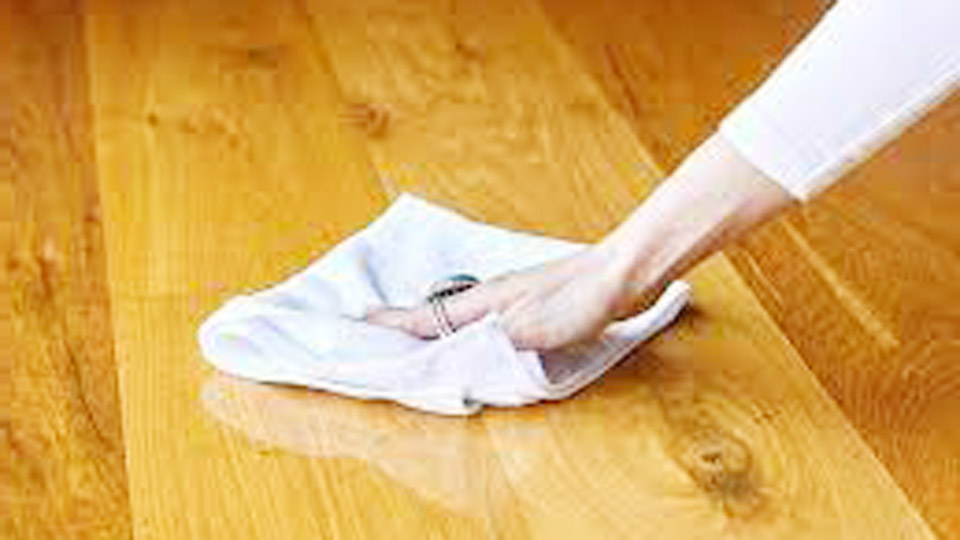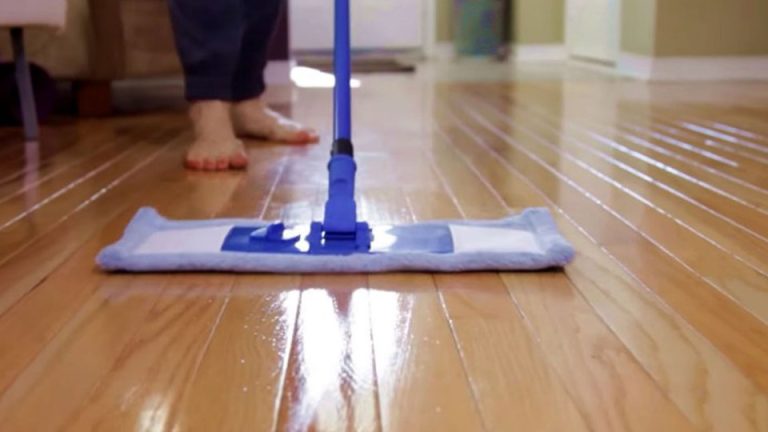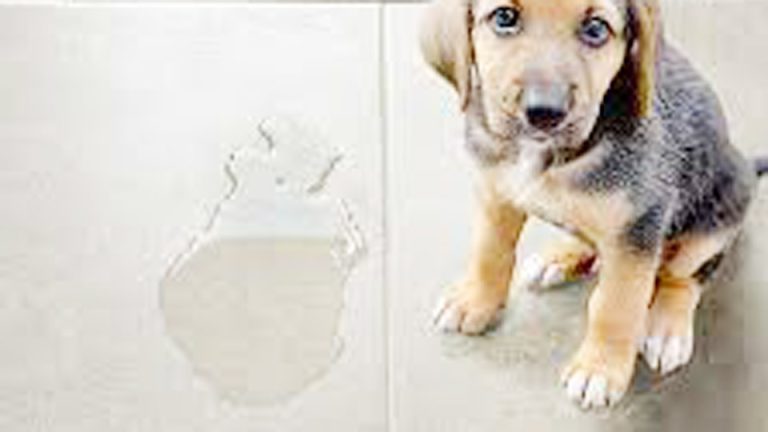My laminate floors have seen it all—muddy paw prints from my dog Max, spilled wine from a lively dinner party, and layers of grime from months of neglect during a busy season. As a home cleaning enthusiast who’s spent years tackling tough messes, I’ve learned that knowing how to clean very dirty laminate floors with vinegar is a lifesaver.
Vinegar is my go-to for its affordability, eco-friendliness, and ability to cut through even the toughest dirt. I discovered its magic when I revived my kitchen laminate after a particularly chaotic holiday season left it looking dull and grimy.
I’ll share my step-by-step methods, personal tips, and real-life stories to help you restore your laminate floors to their sparkling best. If you’re a busy mom or a working professional, these techniques are simple and effective.

Image by 1dayrefinishing
Why Vinegar Works Wonders on Dirty Laminate Floors
I fell in love with vinegar as a cleaner when I tackled a sticky juice spill on my dining room laminate that had dried into a stubborn mess. Vinegar’s acetic acid breaks down grease, lifts dirt, and dissolves grime, making it perfect for very dirty floors. It’s natural, safe for homes with kids and pets, and costs next to nothing compared to store-bought cleaners.
It’s versatile enough to handle everything from caked-on food to pet stains. But laminate floors are sensitive to moisture, so you need to use vinegar carefully to avoid warping or dulling the finish.
Laminate Floors
Before we start cleaning, let’s talk about laminate floors. I’ve cleaned laminate in my kitchen, living room, and hallways, and they’re tricky because they’re made of layered materials with a protective top coat. Too much water or harsh chemicals can seep into seams, causing swelling or damage—I learned this the hard way when I over-mopped my kitchen floor and noticed a slight warp.
Vinegar is safe for laminate when diluted properly, but you’ll want to avoid soaking the floor. Always check your floor’s care instructions or test a small, hidden area first—like under a piece of furniture. Knowing your floor’s needs sets you up for success.
Gathering Your Cleaning Supplies
To clean very dirty laminate floors with vinegar, you’ll need a few simple tools. I keep these in a cleaning caddy for quick access during messes. Here’s what I use:
- White vinegar: Clear, distilled vinegar is best—avoid apple cider vinegar, as it can leave a sticky residue.
- Warm water: Helps dissolve dirt without damaging laminate.
- Liquid dish soap: Optional for extra grease-cutting power.
- Baking soda: For scrubbing tough stains.
- Essential oils (optional): Lemon or tea tree for a fresh scent.
- Spray bottle: For applying cleaner evenly.
- Microfiber mop or cloth: Prevents streaks and lint.
- Bucket: For mixing larger batches.
- Dry microfiber towel: To buff floors and prevent watermarks.
- Soft sponge or old toothbrush: For spot-cleaning stubborn stains.
- Fan (optional): To speed up drying and prevent moisture issues.
These items are budget-friendly and likely already in your home, making this a wallet-friendly solution.
Step-by-Step Guide to Cleaning Very Dirty Laminate Floors
When your laminate floors are caked with dirt or grime, a thorough cleaning is needed. I used this method after neglecting my kitchen floor during a busy month, and it looked brand new afterward. Here’s how to do it:
Sweep or Vacuum First
Start by sweeping or vacuuming to remove loose dirt, dust, and pet hair. I use a vacuum with a hard-floor setting to get into corners and edges where grime hides. This step is crucial to avoid grinding dirt into the floor while mopping. I once skipped this and ended up with scratches on my laminate—never again!
Mix a Vinegar Cleaning Solution
In a bucket, mix ½ cup white vinegar with 1 gallon of warm water. I use warm water because it helps loosen dirt without setting stains. For extra cleaning power on greasy floors, I add 1 teaspoon of liquid dish soap and 5-10 drops of lemon essential oil for a fresh scent. Stir gently to combine. For small areas, use a spray bottle with ¼ cup vinegar, 2 cups water, and a drop of dish soap.
Mop Lightly
Dip a microfiber mop into the solution and wring it out thoroughly—laminate floors hate excess water. Mop in the direction of the floor’s grain to avoid streaks. I work in small sections, about 3×3 feet, to ensure even cleaning.
For very dirty areas, like near my stove, I mop twice, rinsing the mop between passes to avoid spreading grime. Dry each section with a microfiber towel to prevent watermarks or seepage into seams.
Tackle Stubborn Stains
For caked-on stains, like dried food or pet messes, I spritz the area with the vinegar solution and let it sit for 2-3 minutes to loosen the grime. Then, I gently scrub with a soft sponge. I once tackled a dried ketchup stain this way, and it came up without a trace. Rinse the area with a damp microfiber cloth and dry immediately.
Rinse and Dry Thoroughly
Rinse the floor by mopping with plain warm water to remove any vinegar or soap residue, which can attract dirt if left behind. Wring the mop well and work in small sections. Dry the floor with a microfiber towel or set up a fan to speed up drying. I learned to dry thoroughly after leaving my floor damp and noticing a cloudy finish.
Spot-Cleaning Tough Stains with Vinegar and Baking Soda
For really stubborn stains, like grease or pet accidents, I use a vinegar and baking soda paste. This saved my dining room laminate after Max left a dried urine stain I didn’t notice for days. Here’s how:
Make the Paste
In a small bowl, mix 2 tablespoons baking soda with 1 tablespoon white vinegar and 1-2 teaspoons water to form a thick paste. The vinegar makes it fizz, which helps lift stains. I adjust the water for a spreadable consistency.
Apply and Scrub
Apply the paste to the stain with a soft sponge or cloth. I gently rub in circular motions, then let it sit for 5 minutes. For a tough grease stain from a pizza night, this paste worked wonders. Wipe clean with a damp microfiber cloth, rinse with plain water, and dry thoroughly with a microfiber towel to prevent moisture damage.
Tips for Success
Use this paste sparingly, as baking soda is abrasive and can dull laminate if overused. I always rinse thoroughly to remove all residue and test a small area first.
Deep Cleaning for Heavily Soiled Floors
If your laminate floors are very dirty—like mine were after a renovation left them covered in dust and grime—a deep clean is in order. Here’s my process:
Vacuum Thoroughly
Vacuum the entire floor with a hard-floor setting to remove loose dirt and debris. I pay extra attention to corners and edges where dust collects.
Pre-Treat Stubborn Areas
For heavily soiled spots, I spritz my vinegar solution (½ cup vinegar, 1 gallon water, 1 teaspoon dish soap) and let it sit for 5 minutes to loosen grime. I gently scrub with a soft sponge, then wipe clean with a damp cloth.
Mop in Sections
Using the same vinegar solution, I mop in small sections with a well-wrung microfiber mop. I rinse the mop frequently to avoid spreading dirt. For extra-dirty floors, I mop twice, using fresh solution for the second pass. Dry each section with a microfiber towel or fan to prevent moisture buildup.
Buff for Shine
After drying, I buff the floor with a dry microfiber cloth to restore its shine. This step makes my floors look polished and new.
Comparing Vinegar-Based Cleaners for Laminate Floors
I’ve tried various homemade cleaners, and vinegar-based ones are my favorite for dirty laminate floors. Here’s a table comparing my top picks:
| Cleaner | Ingredients | Pros | Cons | Best For |
|---|---|---|---|---|
| Basic Vinegar Cleaner | Vinegar, water, essential oil | Gentle, streak-free, safe for regular use | Not strong enough for heavy grease | Daily or weekly cleaning |
| Grease-Cutting Cleaner | Vinegar, water, dish soap, essential oil | Cuts grease, ideal for kitchens | Can leave residue if overused, needs rinsing | Greasy, very dirty floors |
| Baking Soda Paste | Baking soda, vinegar, water | Lifts tough stains, odor-neutralizing | Abrasive, not for frequent use, needs careful rinsing | Stubborn stains, spot cleaning |
| Water-Only Mopping | Warm water | Safest for laminate, no residue | Less effective on grease or stains | Light dirt or maintenance |
The grease-cutting cleaner is my go-to for very dirty floors, while the basic vinegar cleaner works for regular upkeep. The paste is perfect for spot-cleaning.
Floor-Specific Tips for Laminate
Laminate floors need extra care to stay in top shape. Here’s how I adjust my approach:
Kitchen Floors
Kitchens get greasy, so I use the grease-cutting cleaner with dish soap weekly. I focus on areas near the stove and dry thoroughly to prevent water damage.
Living Room Floors
Living rooms collect dust and pet hair, so the basic vinegar cleaner is perfect for weekly maintenance. I vacuum first to remove debris.
Hallways
High-traffic hallways need frequent cleaning. I use the basic cleaner and mop lightly to avoid over-wetting, drying immediately.
Dining Room Floors
Spills are common here, so I keep the baking soda paste handy for spot-cleaning. I use the basic cleaner for regular upkeep.
Preventing Dirt Buildup on Laminate Floors
Keeping laminate floors clean is easier with some preventative habits. Here’s what I do:
Sweep or Vacuum Regularly
I sweep or vacuum weekly to remove dust and grit that can scratch laminate. A vacuum with a hard-floor setting is my go-to.
Use Mats in High-Traffic Areas
I place washable mats near entrances and sinks to catch dirt and spills. My kitchen mat has saved my floor from countless coffee drips.
Clean Spills Immediately
I tackle spills right away with a damp microfiber cloth and my basic vinegar cleaner to prevent staining. It’s a lifesaver during busy days.
Protect with Furniture Pads
I use felt pads under furniture to prevent scratches. They’ve kept my dining room laminate pristine despite heavy chairs.
Extra Cleaning Hacks I Love
Here are some tricks I’ve picked up to make laminate floor cleaning easier:
Vinegar-Soaked Cloth for Stains: For tough stains, I soak a cloth in the grease-cutting cleaner, lay it on the spot for 5 minutes, then wipe clean.
Microfiber Dusting: I use a dry microfiber mop weekly to grab dust before it settles, reducing the need for deep cleaning.
DIY Shine Booster: Add a drop of olive oil to the basic cleaner for extra shine on dull floors—just a tiny amount to avoid slipperiness.
You’re Ready to Restore Your Floors!
Learning how to clean very dirty laminate floors with vinegar has been a game-changer for my home, and I’m thrilled to share these methods with you. From my grease-cutting cleaner to my baking soda paste, these solutions have tackled every mess, from pet accidents to caked-on grime.
With my step-by-step guide, you can clean your laminate floors with confidence and bring back their shine, even during the busiest weeks. Your home deserves to sparkle, and you’ve got the tools and know-how to make it happen.
Frequently Asked Questions
Can I use apple cider vinegar instead of white vinegar for laminate floors?
I stick to white vinegar because apple cider vinegar can leave a sticky residue and isn’t as effective. White vinegar ensures a streak-free shine.
Will vinegar damage my laminate floors?
When diluted properly, like in my recipes, vinegar is safe for laminate. I avoid over-wetting and dry thoroughly to prevent seepage or damage.
How often should I deep clean very dirty laminate floors?
I deep clean every 1-2 months for heavily soiled floors, using the grease-cutting cleaner. For regular upkeep, I mop weekly with the basic cleaner.
What if my floors look streaky after cleaning?
Streaks usually mean too much cleaner or water. I rinse with a damp microfiber cloth and dry with a towel to restore the shine.
Are these cleaners safe for homes with pets or kids?
Yes, my vinegar-based cleaners are non-toxic and safe for pets and kids. I ensure the floor is dry before anyone walks on it to avoid tracking dirt.


